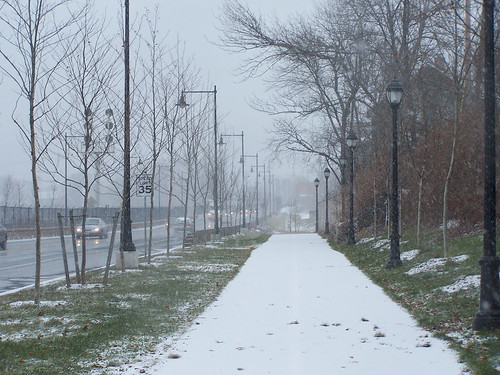
Even after only four months, it is very apparent that Salem’s Last Road has changed traffic patterns in Salem. It has also changed neighborhoods.
The road, centered on the new triangular parkland at St. Peter’s St., has divided the Bridge St. area into three distinct neighborhoods.
The first neighborhood is my own, the section of St. Peter’s St. and Bridge going southeast towards Federal and Church Sts. It includes Ash St., the steep street between my building and the Unitarian church, and extends out to Washington St.
This has changed the least out of the three. It’s more or less the same neighborhood I found when I moved into my current apartment in 1995. Parker Brothers was demolished around the same time I moved in, and the Jail was long closed.
I have the same traffic noise I always have, and the train noise to let me know when I oversleep and miss the 7:05 to Boston. Bridge St. is no longer the intimate and very congested street it was when I came, but is a full 4-1/2 lane highway. I have mixed feelings about that.
The sidewalk along Bridge St. was very dangerous to traverse in 1995, with the steep drop and broken fence at the old Harley-Davidson dealership at 234 Bridge St. It is much safer now, even if it lacks character. Despite what I first feared when the road opened, I have no trouble getting to Salem Depot on time for my bus or train with a crosswalk just steps from the door.
The second neighborhood created by the bypass road is really two neighborhoods. The first one goes from St. Peter St. northeast, away from downtown, out to Winter St. where Route 1A curves south from Bridge St. to Salem Common and Hawthorne Boulevard.
This area between 1A and 107 is very quiet with the new roadway. Standing at the Howard St. Cemetery above the Salem Jail, you would hardly know there is a busy road. The triangular park is a very effective buffer against road noise. If the Jail is developed, its residents will find it a nice refuge virtually in downtown.
The second part of this neighborhood extends from Winter St. northeastwards to the bridge. This hasn’t changed a lot, but it has subtly changed as most of the heavy truck traffic is now off Bridge St. This is for the better.
Of course, all of the neighborhoods I’ve talked about are connected by a very nice bikepath which has gotten rave reviews by most who have walked it, myself included.
The third and last neighborhood, unfortunately, is not really a neighborhood at all. It is the saddest example of development anywhere in the city.
It is the Jefferson, stretching north from Salem Depot, along the old Parker Brothers property out to Howard St. on the southbound lane of Bridge St. It is nine apartment buildings cut neatly in half by the bypass road. For all intents and purposes, the Jefferson is almost completely isolated from the rest of the city by Bridge St. and the bypass road, especially buildings 5 through 9 on the Howard St. side which make a tight triangle isolated from every other neighboring street.
The fault is entirely on former mayor Stan Usovicz’s shoulders.
As much as I opposed the routing of the road, I can forgive that and I can probably even accept it now.
But the process that led to a fly-by-night developer erecting cheap and probably dangerous buildings was one of the worst things to happen to Salem since the old Depot was demolished.
There were many many possibilities for development, even with the routing of the road that was selected. It was rumored a hotel chain was interested—the bypass road would have been a boon for them! There was talk about building the courthouse complex there. Imagine no over-sensitive neighbors to complain (I certainly wouldn’t have!) Imagine reusing part of the Parker Brothers complex for offices or even an inn!
But no, Stan did what was cheapest and quickest. People in the Jefferson are cursing; I have already had comments in my blog about the noise that Jefferson dwellers experience from the road. Someday, some child trying to get to his friend’s house across the road will be killed. One hopes there won’t be a fire as there was at the complex in Peabody.
That poor decision to develop is responsible for all the ills that the road has caused in Salem. The road could have been better, but it hasn’t turned out to be the nightmare I feared it would be. The Jefferson, on the other hand, is different.
Stan Usovicz needs to admit to his culpability. If more retired officials thought about what their decisions meant to Salem, 10, 20 years down the road or longer, they might have made better decisions. Perhaps we would demand—and have—better officials.
Who knows, the Old Salem Depot and Leslie’s Retreat Bridge might be still with us. And we might have had a great development on Bridge St. making money for the city.
Instead of crapbox apartments hemmed in by a highway.
No comments:
Post a Comment